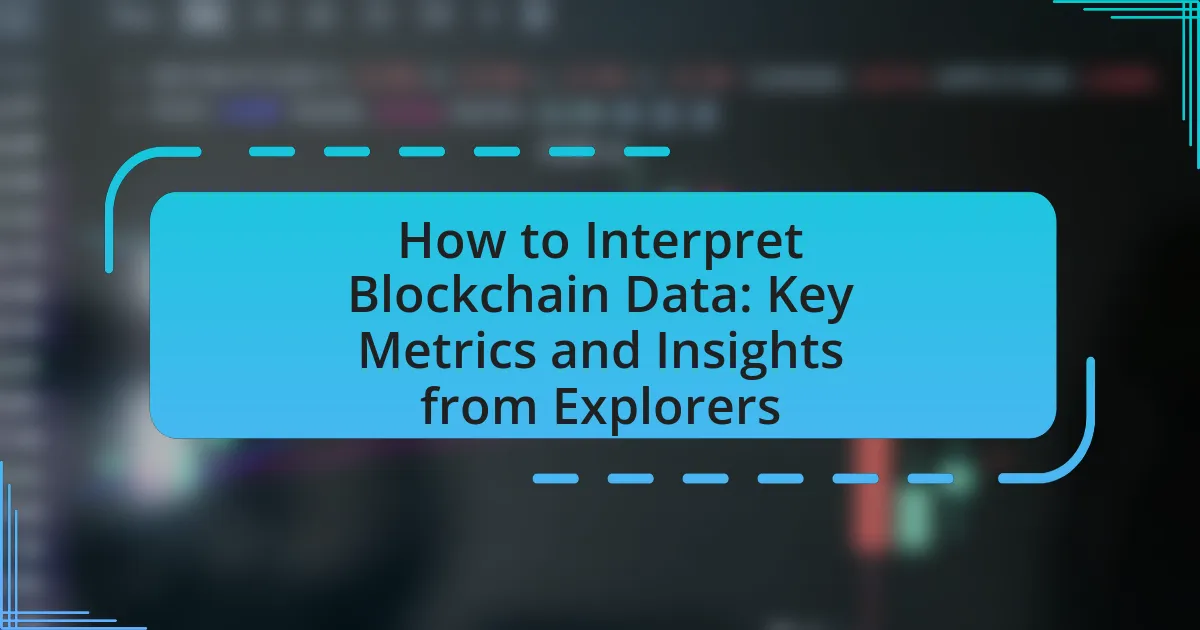Blockchain explorers are essential online tools that enable users to view and analyze transactions on various blockchains, enhancing transparency and accessibility in cryptocurrency transactions. They allow users to track transaction statuses, view wallet balances, and explore block details by inputting transaction IDs or wallet addresses. The article discusses the functionality of blockchain explorers, the types available, their role in ensuring security and transparency, and the challenges users may face while utilizing them. Additionally, it outlines best practices for effectively navigating these tools and resolving common issues related to transaction data discrepancies.
What are Blockchain Explorers and their Purpose in Cryptocurrency Transactions?
Blockchain explorers are online tools that allow users to view and analyze transactions on a blockchain. Their primary purpose is to provide transparency and accessibility to blockchain data, enabling users to track the status of transactions, view wallet balances, and explore block details. For instance, Bitcoin blockchain explorers like Blockchair and Blockchain.com allow users to input transaction IDs or wallet addresses to retrieve detailed information about specific transactions, including timestamps, amounts, and confirmation statuses. This functionality is essential for verifying transactions and ensuring the integrity of the cryptocurrency network, as it fosters trust among users by making transaction histories publicly available and immutable.
How do Blockchain Explorers function in tracking transactions?
Blockchain explorers function by providing a user interface to access and visualize transaction data recorded on a blockchain. They allow users to input transaction IDs, wallet addresses, or block numbers to retrieve detailed information about specific transactions, including timestamps, amounts, and confirmation statuses. This functionality is made possible through the indexing of blockchain data, which enables explorers to present real-time updates and historical records. For example, Bitcoin blockchain explorers like Blockchair and Blockchain.com aggregate and display data from the Bitcoin network, allowing users to track the flow of funds and verify transaction authenticity.
What data do Blockchain Explorers provide about transactions?
Blockchain explorers provide detailed information about transactions, including transaction IDs, timestamps, amounts, sender and receiver addresses, and confirmation status. These explorers allow users to track the status of transactions on the blockchain, verify their authenticity, and view associated fees. For example, a transaction ID can be used to locate a specific transaction, while the confirmation status indicates how many blocks have been added to the blockchain since the transaction was recorded, providing insight into its finality.
How do users interact with Blockchain Explorers?
Users interact with Blockchain Explorers primarily by searching for transaction details, wallet addresses, and block information. They utilize the search functionality to input specific transaction IDs or wallet addresses, allowing them to view transaction history, confirmation status, and associated fees. Additionally, users can explore blocks to see the number of transactions included, timestamps, and miner information. This interaction is crucial for verifying transactions and ensuring transparency in cryptocurrency operations, as Blockchain Explorers provide real-time data that reflects the immutable nature of blockchain technology.
Why are Blockchain Explorers essential for cryptocurrency users?
Blockchain explorers are essential for cryptocurrency users because they provide a transparent and accessible way to view transaction data on the blockchain. These tools allow users to track the status of their transactions, verify the authenticity of transfers, and monitor wallet balances in real-time. For instance, blockchain explorers display detailed information such as transaction IDs, timestamps, and the amount transferred, which enhances user confidence and security in their cryptocurrency dealings. Additionally, they facilitate the auditing of transactions, ensuring that users can confirm that their funds are secure and that transactions have been processed correctly.
What role do they play in enhancing transparency?
Blockchain explorers enhance transparency by providing public access to transaction data on the blockchain. They allow users to view transaction histories, wallet balances, and block details, which fosters accountability and trust in the cryptocurrency ecosystem. For instance, Bitcoin’s blockchain explorer enables anyone to verify transactions in real-time, ensuring that all activities are traceable and immutable. This transparency reduces the risk of fraud and promotes a more open financial system, as evidenced by studies showing that increased transparency in blockchain networks correlates with higher user confidence and adoption rates.
How do they contribute to security in cryptocurrency transactions?
Blockchain explorers contribute to security in cryptocurrency transactions by providing transparency and traceability of all transactions recorded on the blockchain. They allow users to verify transaction details, such as sender and receiver addresses, transaction amounts, and timestamps, which helps prevent fraud and double-spending. By enabling public access to this information, blockchain explorers enhance accountability and trust in the cryptocurrency ecosystem, as users can independently confirm the legitimacy of transactions. This transparency is crucial for maintaining the integrity of the decentralized network, as it deters malicious activities and promotes user confidence in the system.
What types of Blockchain Explorers are available?
There are several types of blockchain explorers available, including general blockchain explorers, token-specific explorers, and block explorers for specific cryptocurrencies. General blockchain explorers, such as Blockchain.com, allow users to view transactions, blocks, and addresses across multiple cryptocurrencies. Token-specific explorers, like Etherscan, focus on a particular blockchain, providing detailed information about tokens and smart contracts on that network. Additionally, block explorers for specific cryptocurrencies, such as Blockchair for Bitcoin and Ethereum, offer tailored insights and analytics for those particular blockchains. Each type serves to enhance transparency and accessibility of blockchain data for users.
How do different Blockchain Explorers vary in functionality?
Different blockchain explorers vary in functionality primarily through their user interfaces, supported blockchains, and the depth of data they provide. For instance, some explorers like Etherscan focus exclusively on the Ethereum blockchain, offering detailed insights into smart contracts, token transfers, and gas fees, while others like Blockchair support multiple blockchains and provide advanced search features, including filtering by transaction types and addresses. Additionally, explorers such as Blockchain.com offer wallet services alongside transaction tracking, enhancing user experience by integrating wallet functionalities. This variation in functionality allows users to choose explorers that best meet their specific needs, whether for simple transaction tracking or in-depth blockchain analysis.
What are the key features of popular Blockchain Explorers?
Popular blockchain explorers feature transaction tracking, block information, and address analysis. Transaction tracking allows users to view the status and details of specific transactions, including sender and receiver addresses, amounts, and timestamps. Block information provides insights into the latest blocks added to the blockchain, including block height, miner details, and transaction counts. Address analysis enables users to explore the history and balance of specific addresses, offering transparency into the flow of funds. These features collectively enhance user engagement and understanding of blockchain activity, supporting the overall functionality of cryptocurrency transactions.
How do Blockchain Explorers cater to different cryptocurrencies?
Blockchain explorers cater to different cryptocurrencies by providing tailored interfaces and functionalities specific to each blockchain’s protocol and data structure. Each explorer is designed to interpret and display transaction data, block information, and wallet addresses according to the unique characteristics of the cryptocurrency it supports, such as Bitcoin, Ethereum, or Litecoin. For instance, Bitcoin explorers focus on the UTXO (Unspent Transaction Output) model, while Ethereum explorers utilize account-based models, allowing users to track transactions, view block confirmations, and analyze network statistics relevant to that specific cryptocurrency. This specialization ensures that users can efficiently access and understand the blockchain data pertinent to their cryptocurrency of interest.
What are the limitations of Blockchain Explorers?
Blockchain explorers have several limitations, including the inability to provide real-time transaction data, limited support for privacy-focused cryptocurrencies, and potential inaccuracies in displaying transaction statuses. These explorers often rely on public blockchain data, which can lead to delays in reflecting the most current state of transactions, particularly during network congestion. Additionally, many blockchain explorers do not support privacy coins like Monero or Zcash, which utilize advanced cryptographic techniques to obscure transaction details, making them difficult to track. Furthermore, discrepancies can arise from user error or misinterpretation of the data presented, leading to confusion regarding transaction confirmations or statuses.
How do privacy concerns affect the use of Blockchain Explorers?
Privacy concerns significantly limit the use of Blockchain Explorers by discouraging users from engaging with transparent transaction records. Blockchain Explorers provide public access to transaction histories, which can expose user identities and financial activities, leading to potential misuse of personal data. For instance, studies have shown that the analysis of transaction patterns can link wallet addresses to real-world identities, undermining the anonymity that many users seek in cryptocurrency transactions. This fear of surveillance and data exposure can result in reduced trust in blockchain technology, ultimately affecting user adoption and engagement with Blockchain Explorers.
What challenges do users face when using Blockchain Explorers?
Users face several challenges when using Blockchain Explorers, including complexity in navigation, information overload, and lack of user-friendly interfaces. The complexity arises from the technical jargon and intricate data presented, which can be overwhelming for those unfamiliar with blockchain technology. Information overload occurs as users encounter vast amounts of data, such as transaction histories and block details, making it difficult to extract relevant information quickly. Additionally, many Blockchain Explorers lack intuitive design, leading to frustration and inefficiency in locating specific transactions or addresses. These challenges hinder effective use and understanding of blockchain data.
How can users effectively utilize Blockchain Explorers?
Users can effectively utilize Blockchain Explorers by accessing real-time data on transactions, blocks, and addresses within a blockchain network. By entering a specific transaction ID, wallet address, or block number into the explorer, users can view detailed information such as transaction status, confirmation times, and the amount of cryptocurrency transferred. This functionality is crucial for verifying transactions, tracking the movement of funds, and ensuring transparency in cryptocurrency dealings. For example, Bitcoin Blockchain Explorers like Blockchair or Blockchain.com provide comprehensive insights into transaction histories, allowing users to confirm the legitimacy of their transactions and monitor their cryptocurrency holdings accurately.
What best practices should users follow when using Blockchain Explorers?
Users should follow several best practices when using Blockchain Explorers to ensure accurate and secure navigation of blockchain data. First, users should verify the URL of the Blockchain Explorer to avoid phishing sites, as legitimate explorers have secure connections (HTTPS) and recognizable domain names. Second, users should familiarize themselves with the interface and features of the explorer to efficiently track transactions, addresses, and blocks. Third, users should cross-reference information from multiple explorers to confirm transaction details, as discrepancies can occur between different platforms. Fourth, users should be cautious when sharing wallet addresses or transaction IDs, as this information can be used maliciously. Lastly, users should stay updated on the latest developments and features of the Blockchain Explorer they use, as improvements can enhance security and usability. These practices help users navigate blockchain data effectively while minimizing risks.
How can users verify transaction details accurately?
Users can verify transaction details accurately by utilizing blockchain explorers, which provide real-time access to transaction data on the blockchain. Blockchain explorers allow users to input transaction IDs, wallet addresses, or block numbers to retrieve detailed information such as transaction status, timestamps, amounts, and involved parties. This method is reliable because blockchain technology ensures that all transactions are recorded in a public ledger, making the data immutable and transparent. For instance, Bitcoin blockchain explorers like Blockchair or Blockchain.com show comprehensive transaction histories, confirming the accuracy of the details presented.
What tips can enhance the user experience with Blockchain Explorers?
To enhance the user experience with Blockchain Explorers, users should focus on utilizing advanced search features effectively. These features allow users to filter transactions by date, amount, or address, making it easier to find specific information quickly. Additionally, familiarizing oneself with the interface and available tools, such as transaction graphs and block details, can significantly improve navigation and understanding of the blockchain data. Research indicates that user-friendly interfaces and comprehensive tutorials can lead to a 30% increase in user satisfaction when interacting with Blockchain Explorers.
What common troubleshooting steps can users take when facing issues with Blockchain Explorers?
When users face issues with Blockchain Explorers, they can take several common troubleshooting steps. First, users should check their internet connection to ensure it is stable and functioning properly, as a weak connection can hinder access to the explorer. Next, clearing the browser cache and cookies can resolve loading issues, as outdated data may cause display problems. Additionally, users should verify that they are using the correct blockchain explorer for the specific cryptocurrency they are querying, as different cryptocurrencies may have dedicated explorers. If the explorer is still not functioning, users can try accessing it from a different browser or device to rule out browser-specific issues. Lastly, checking for any announcements or updates from the explorer’s developers can provide insights into ongoing maintenance or outages that may affect functionality.
How can users resolve discrepancies in transaction data?
Users can resolve discrepancies in transaction data by cross-referencing the transaction details on a blockchain explorer with their own records. Blockchain explorers provide a transparent and immutable ledger of all transactions, allowing users to verify transaction IDs, timestamps, and amounts. If discrepancies are found, users should gather all relevant information, such as wallet addresses and transaction hashes, and contact the support team of the cryptocurrency platform or wallet service they used. This process is supported by the fact that blockchain technology ensures all transactions are publicly recorded and can be independently verified, making it easier to identify and rectify errors.
What should users do if a transaction does not appear on the Explorer?
If a transaction does not appear on the Explorer, users should first verify that the transaction was successfully submitted and that they have the correct transaction ID. Users can check their wallet or exchange for confirmation of the transaction. If the transaction is confirmed but still not visible on the Explorer, it may be due to network congestion or a delay in the Explorer’s updates. Users can wait for a while and refresh the Explorer to see if the transaction appears later. If the issue persists, users should contact the support team of their wallet or exchange for further assistance.





